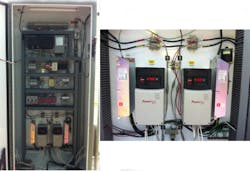Control and Cleaning Resolution Improves Plant Efficiency
At a steam plant in Salinas, the Puerto Rico Electric Power Authority (PREPA) was looking for a way to recover a 0.5 percent loss of efficiency worth more than $2 million per year. They found it through a comprehensive sensor solution with a difficult controls challenge.
The Aguirre Steam Plant Unit 1 is an oil-burning, tangential-fired combustion engineering unit rated at 450 MW. There are four elevations of burners with a burner at each corner for a total of 16 burners. The unit has two three-layer bisector Lungstrom rotating air heaters, and no particulate collection device with individual stacks per air heater. They burn Bunker C oil with a sulphur content of 0.5 percent.
To minimize the effect of acid deposition on the air heater and the resulting pluggage, the plant typically operated with a gas outlet temperature of 305 °F, maintained by steam coils pre-heating the air going into the air heater. This resulted in the efficiency loss that PREPA wanted to address. They were interested in a solution that would allow them to minimize air heater pluggage, keep the heater clean and minimize air pre-heat.
Air heater cannot be shut down
Breen Energy, which helps utilities manage emissions, presented a solution to PREPA that included a system to measure the condensable levels using an AbSensor, a thermodynamic model to predict the condensation depth in the air heater (TherMAP), a control system to maintain the depth within the cleanable cold end, and a dynamic speed controlled (DySC) soot blowing system that could keep the air heater clean.
However, Breen faced several engineering challenges. The air heater, a critical part of the power plant, cannot shut down at any time for any reason. The air heater has enormous mass and therefore requires high torque at lower speeds. It also acts like a flywheel once it is running, so slowing it down requires higher braking capacity. A control system needed to be designed that provided a high degree of reliability and availability, which implied redundancy.
Adaptive Resources set about designing a high-reliability solution, the first part of which was to go with a sensorless vector drive instead of a traditional variable-frequency drive (VFD). A vector drive is designed to deliver maximum torque even at low frequencies and speed regulation to 0.1 percent using back-EMF to measure speed. We also designed an electrical system that allowed the backup drive to come online at the same speed as the primary in the event of a failure. Other features included redundant sensors, ControlNet, Ethernet and PLC systems.
Stack temperatures reduced
The system has shown excellent results in reducing the stack temperatures while preventing air heater fouling and any subsequent unit derates or shutdowns for cleaning. The steam coils have been essentially shut down and are not expected to be needed for normal operation unless the plant decides to go to a higher-sulphur fuel or the ambient air temperature drops significantly. Average stack temperature has dropped by 15 °F.
A high-reliability system that ensures the air heater keeps running at all speeds during DySC soot blowing was essential to the success of this project. The system designed includes redundancy at every level including the sensors, drives, communications and control logic processors.
The reduced stack gas temperatures represent a little less than 0.5 percent improvement in efficiency. At $80+ per barrel of oil, this represents a savings of $1.5 million to $2 million per year.
>> Chetan Chothani is President and Eliseo Rodriguez is Vice President of Operations at Adaptive Resources (www.adaptiveresources), a member of the Control System Integrators Association (CSIA, www.controlsys.org).
About the Author
Chetan Chothani and Eliseo Rodriguez
President and Vice President of Operations, Adaptive Resources

Leaders relevant to this article:
